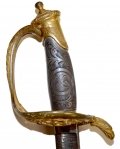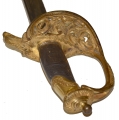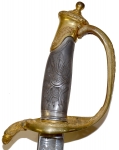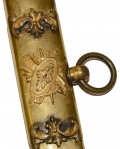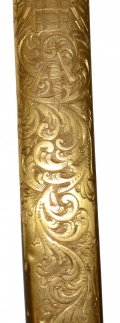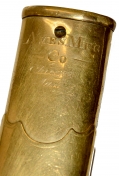site search
online catalog
MINTY SILVER GRIP AMES HIGH GRADE PRESENTATION STAFF AND FIELD SWORD PRESENTED TO MAJOR H.D. JOHNSON, JR., AN OFFICER IN THE VIRGINIA BRIGADE (U.S.) OF WARD HILL LAMON, LINCOLN’S CONFIDANT, BODYGUARD, AND US MARSHAL D.C.

$11,500.00 SOLD
Quantity Available: None
Item Code: 870-440
This beautiful and unique, custom order officer’s sword, formerly in the Kevin Hoffman collection, is illustrated on pages 286-287 of Thillmann’s essential “Civil War Army Swords.” It also has a connection to Ward Hill Lamon, Lincoln’s bodyguard, photographed with him at Antietam and at the delivery of the Gettysburg Address.
The sword is very high quality, featuring an engraved silver grip, a deeply cast, chased and engraved hilt with lots of gilt finish, and a fully engraved brass scabbard, also loaded with gilt, that bears an engraved Ames company address. The blade is marked “Iron Proof” on the spine, indicating it is may be by Clauberg, though it is wonderfully etched, likely by Ames as part of the final product. To add to its unique features, it has a great 1862 presentation on the scabbard, and a second presentation on a separate plaque that was added in 1871.
The brass hilt is deeply cast and chased in detail with rich gilt finish remaining. (Only the ball finial on the pommel, a natural point of handling, shows any appreciable wear to the underlying brass.) Instead of a floating U.S., the guard incorporates a wonderful eagle with a U.S. shield on its chest, raising its wings amid the floral scrolls. This is complemented by a detailed eagle head quillon, and mirrored in the beautiful engraving of the silver grip. Both sides of the grip have bordered panels. The reverse features a “trophy” or panoply of arms with a Liberty Cap on a pole prominently jutting up from a large cluster of muskets, pikes, banners, drums, and trumpet, with a shield superimposed at center. The obverse is filled with wonderful floral scrolls and sprays surrounding a round central cartouche in which an eagle raises its wings and clutches not an olive branch and arrows, but arrows in both claws, making clear its business is war.
The blade etching is vivid against the frosted background. The obverse features floral scroll work at bottom in a panel terminating in an Arabesque point. The same Arabesque arch point marks the ends of a longer panel above showing a dynamic eagle with widespread wings, an “E Pluribus Unum” ribbon overhead in a wreath-like circle, and spears or pikes angling to the left, in the same direction as the eagle’s head. The obverse has two Arabesque terminated panels as well, the lower with floral motifs and the upper with floral scrolls and a “U.S.” The blade overall is superb: in the bright, no nicks, and with bright, vivid etching.
The gilt scabbard has an engraved Ames address on the upper reverse: “AMES MFG /~CO~ / Chicopee / Mass.” The obverse has five deeply cast and chased applied floral sprays or “raffles” marking off the carrying rings and delineating two engraved panels, and a deeply cast and chased floral drag. The carrying rings are mounted on the scabbard without bands, with an ornate floral button under the top ring and a small trophy of arms with an oblong shield under the lower ring, both framed by the applied sprays. The lower of the two engraved panels consists of a tall panoply of arms, with flags, halberds, topped by a dragoon-style crested helmet, with scrolls and other elements densely engraved underneath. Thillmann remarks that the panoply is the one, “so often seen on Ames presentation and high grade sword scabbards.”
The upper panel has a very nicely engraved presentation: “To Major H.D. Johnson Jr. / 1st Regt. Virginia Brigade / U.S. Vols - By his / Brother Officers. / 1862.” The “Virginia Brigade” was a composite brigade assembled at Williamsport, Md., in late summer 1861 to patrol and guard points along the Virginia-Maryland border along the Potomac. Ward Hill Lamon, one of Lincoln’s confidants, biggest supporters, in zeal and physical stature, something of a loose cannon, and acted as Lincoln’s informal bodyguard, getting an appointment also as U.S. Marshall of D.C.
Lamon decided to take the field in late summer 1861, assuming that he had enough pull to get a general’s commission if he could raise enough men. He was likely right about his influence (the Secretary of War authorized his drawing of arms and equipment,) if premature in actually donning the general’s uniform. Accustomed to cutting corners, Lamon ended up pulling into his orbit the 39th Illinois, the 13th Mass., and the 12th Indiana, along with some cavalry and two batteries of artillery out of Pennsylvania, though the cost of transferring the Illinois regiment to Washington was something of a scandal.
Added to this mix was a regiment, though never fully up to strength, recruited initially in New York and nicknamed the “Oregon Rifles,” claiming sponsorship by former Oregonians in NY City and representatives in Washington, with the promise of some companies of Oregon backwoods marksmen as well. An August 1861 NY advertisement lists the colonel as J. Dow Williamson, “a gentleman of great military experience and considerable means,” who had been booted out as colonel of the 1st Regiment of the Excelsior Brigade in May and apparently decided to go off on his own hook. Henry D. Johnson, Jr., is listed in the same notice as major: “Major Johnson is also a thorough military officer, having seen long and active service, and is certainly an excellent selection.”
No particulars of their backgrounds are given. Neither seems to have actually held a commission, the ranks being dependent upon raising the regiment, but in one way or another with Johnson and Williamson both still Major and Colonel, the regiment had joined Lamon’s brigade at Williamsport by September. A NY Times article of 9/28/61 lists them as officers, along with a lt. colonel and notes they were actively looking for recruits, listing the differing ranks offered to hopeful officers depending on the number of recruits they could bring in. The article specifically titles them, the “First Regiment (Oregon Rifles) Virginia Brigade.” Reminiscences by other regiments in the brigade noted the regiment was also Virginians who crossed into Maryland out of loyalty to the Union or to escape military service under the Confederacy and had run out of money hanging around Williamsport. A number of Marylanders were likely in the ranks as well.
Falling under Nathaniel Banks’ command in Maryland, the brigade did see some action. Elements skirmished with Confederates along a substantial stretch of the river in small actions and patrols and, most notably, fought Stonewall Jackson in his effort to destroy Dam No. 5 along the C & O Canal in December 1861. Lamon, however, never received his general’s commission and returned to his duties as U.S. Marshal, one of the regimental commanders taking over temporary command. Given the date of the sword presentation, Johnson was still on duty with the regiment as major in 1862.
In March 1862, when campaigning began again, the brigade was broken up with the various units joining other organizations. The First Regiment was disbanded with its four, or so, companies consolidated in the 3rd Maryland. The field officers at that point must have gone their own ways since they lacked formal commissions. (Williamson had gotten into legal troubles in New York City for obtaining military supplies for the outfit from a supplier without authority.) We do not find further record of Johnson in the field, but he apparently kept up his interest in the military. As late as 1886 he is noted in a Brooklyn newspaper as collecting information for a history of the National Guard.
Johnson and his sword, however, had parted ways by 1871. When originally found the presentation inscription to Johnson was covered by a slightly loose, engraved plaque mounted using three holes, and reading, “Presented to / Captain William M. Strachan / by the active and honorary members / of Co. E 9th Regt. MVM as a token of their esteem / March 29th, 1871.” How the members of the 9th Massachusetts Volunteer Militia got it is unknown. Strachan (1830-1892) had a long military career, serving as sergeant in the Seaforth Highlanders before emigrating to America in 1856. He saw Civil War service in the 9th Massachusetts Infantry, twice enlisting and being discharged for disability in 1861 and 1862, and then persisted by joining the 4th Mass. Heavy Artillery in August 1864, from which he was discharged as a lieutenant in June 1865. He was elected captain of Co. E, 9th Mass. Vol. Militia in 1869 and rose to colonel in 1879, a rank he held until his death in 1892. However his friends obtained the sword for him, they had great taste.
The only flaw we can find is the three small holes made for the second plaque, and some rubbing to the gilt finish on the ball finial of the pommel, the sides of scabbard below the last, long flourishes of the floral scrolls on the obverse, and on the lower portion of the plain reverse, where it would naturally rub against the leg of an officer wearing it (all natural points of contact and wear.) The sword has an interesting and complex history, with more to be done on it, relating to the tumultuous first year of the war as military needs, politics, and personal ambitions collided as both sides struggled to gain their footing for the conflict. Even without that, this is a superb sword for quality and condition. [sr]
~~~~~~~~~~~~~~~~~~~~~~~~~
THIS ITEM, AS WITH ALL OTHER ITEMS AVAILABLE ON OUR WEB SITE,
MAY BE PURCHASED THROUGH OUR LAYAWAY PROGRAM.
FOR OUR POLICIES AND TERMS,
CLICK ON ‘CONTACT US’ AT THE TOP OF ANY PAGE ON THE SITE,
THEN ON ‘LAYAWAY POLICY’.
THANK YOU!
Inquire About MINTY SILVER GRIP AMES HIGH GRADE PRESENTATION STAFF AND FIELD SWORD PRESENTED TO MAJOR H.D. JOHNSON, JR., AN OFFICER IN THE VIRGINIA BRIGADE (U.S.) OF WARD HILL LAMON, LINCOLN’S CONFIDANT, BODYGUARD, AND US MARSHAL D.C.
For inquiries, please email us at [email protected]
Most Popular
Historical Firearms Stolen From The National Civil War Museum In Harrisburg, Pa »
Theft From Gravesite Of Gen. John Reynolds »
Cavalry Carbine Sling Swivel »
Fine Condition Brass Infantry Bugle Insignia »
featured item
THE NORFOLK LIGHT ARTILLERY BLUES! IMPRESSIVE HALF PLATE DAGUERREOTYPE BY WHITEHURST IN A WONDERFUL WHITEHURST CASE
This image is not only mounted with a Whitehurst marked mat, but has a full thermoplastic figural case with a purple velvet facing pad embossed with a large eagle flourishing a ribbon reading “J.H. Whitehurst” and holding a shield or plaque with… (1138-1799). Learn More »






